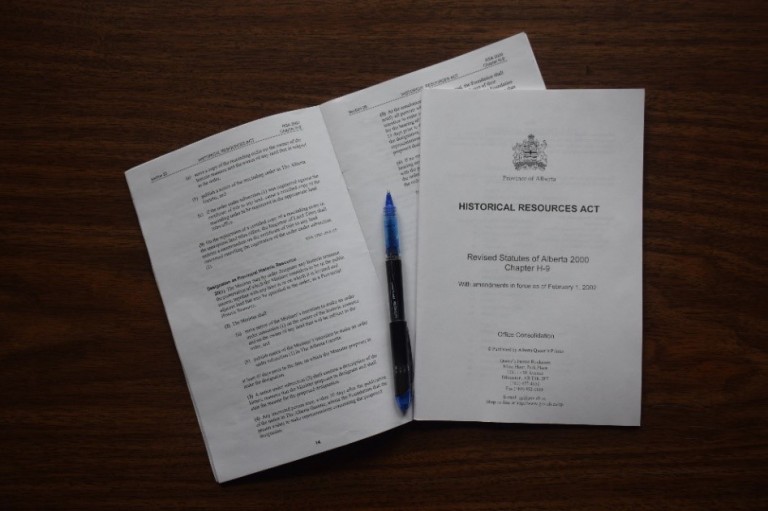Written by: Peter Melnycky, Historian, Historic Resources Management Branch
Editor’s note: Welcome to the first in a series of blog posts developed with municipalities in mind who either have or are considering undertaking Municipal Historic Resource designation. This series is intended to serve as a refresher on how to evaluate sites, develop Statements of Significance, determine periods of significance and develop Statements of Integrity.
For more information, please review the “Creating a Future” manuals available here or contact Rebecca Goodenough, Manager, Historic Places Research and Designation at rebecca.goodenough@gov.ab.ca or 780-431-2309.
Determining eligibility
In our first post, we will be discussing how to determine if a historic place is eligible for designation.
Historic resources include structures, buildings, landscape and archaeological features, all of which can be considered for protection by a municipality. Under the Historical Resources Act, municipalities have the ability to designate historic resources under a bylaw to ensure their protection.

In order to be considered for protection as a Municipal Historic Resource, a site needs to:
- Be an eligible resource type
- Possess historical significance
- Have sufficient material integrity
If a site meets all three of these of these criteria, it can be considered for Municipal Historic Resource designation.
There are five scenarios where historic resources are not eligible for designation.
Outside of the municipality’s jurisdiction
Historic resources located on federal lands or on lands outside of the municipal boundaries are not eligible for municipal designation.

Part of a historical park or outdoor museum
Grouping of buildings relocated outside of the living parts of their communities to places that have been created for the purposes of interpretation, protection, or maintenance are not eligible. Creating such a grouping destroys the integrity of location and setting, and can create a false sense of historic development.

Small, moveable objects
Small moveable objects are not eligible. Such works include transportable artefacts, sculpture, furniture, and other decorative arts that, unlike a fixed outdoor sculpture, do not possess association with a specific place.
Reconstructions
Reconstruction is defined as the process of recreating the exact form and detail of a vanished resource or major part thereof. A resource in which most or all of the fabric is not authentic is not eligible for designation.

Human remains
Human remains are typically beyond the purview of the Historical Resources Act and therefore are not eligible for designation.
There are five additional scenarios where historic resources are ordinarily not eligible for designation but may be considered in certain circumstances.
Cemeteries
Cemeteries serve as a primary means of an individual’s recognition of family history and as expressions of collective identity. A cemetery may qualify if it derives its primary significance from distinctive design features or is associated with a significant event (note that in all circumstances, cemeteries are designated exclusive of any human remains).


Birthplaces or graves
The lives of persons significant in our past normally are recognized by the designation of resources that illustrate or are connected with that person’s productive life’s work. The birthplace or grave of a figure of importance may qualify if there is no other appropriate resource associated with his or her productive life (note that in all circumstances, cemeteries are designated exclusive of any human remains).

Resources that have been moved
Moving a resource destroys the relationships with its surroundings. A move may also cause the loss of historic features such as landscaping, foundations, and chimneys. A resource removed from its original location may qualify, if it:
- was moved early in its history and developed significant historical associations on its new location prior to the last 50 years
- is primarily significant for its exceptional architectural value
- is the sole surviving resource most importantly associated with an historic theme, event, activity, person or institution
- was specifically designed to be relocated as part of its normal use
- is in the immediate vicinity of its original location and its association with its historic environment is maintained

Resources that are primarily commemorative
Commemorative resources are designed or constructed after the occurrence of an important event or after the life of an important person. They are not directly associated with the event or with the person’s productive life, but serve as evidence of a later generation’s assessment of the past. A commemorative resource generally must be over fifty years old and must possess significance based on its own value, not on the value of the event or person being memorialized.

Resources that less than 50 years old
Fifty years is generally accepted as the amount of time needed to develop historical perspective and for a historic resource to acquire significance. This consideration ensures that historic resources pass contemporary interest and that Alberta’s designated resources are truly historic places. A resource that has achieved significance in the last 50 years may qualify for exemption from this exclusion, if:
- it can be demonstrated that the resource is extraordinarily significant under any of the five significance criteria
- it is particularly fragile, of high significance, and would probably not survive for 50 years without protection
Once it has been determined that a historic resource is eligible for designation, the next step is to analyze the resource to determine if it possesses historical significance. This will be covered in our next blog post.


Well done Peter,
Nice piece,
Ian C.
Ian – Thanks for the visit and the comment.